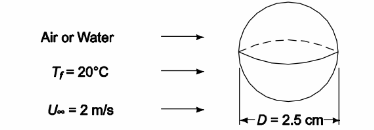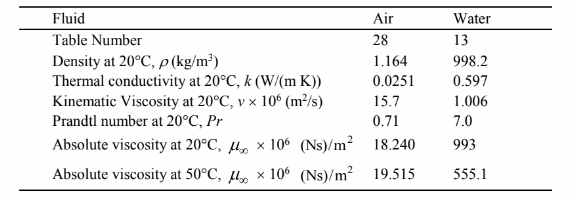A 2.5 cm sphere is maintained at 50°C in either an air stream or a water stream, both at 20°C and 2 m/s velocity. Compare the rate of heat transfer and the drag on the sphere for both fluids.
GIVEN
• A sphere in an air stream or a water stream
• Sphere diameter (D) = 2.5 cm = 0.025 m
• Sphere temperature (Ts) = 50°C
• Fluid temperature (Tf) = 20°C
• Fluid velocity (U?) = 2 m/s FIND
• The rate of heat transfer (q) and the drag force
ASSUMPTIONS
• Radiation is negligible
SKETCH

PROPERTIES AND CONSTANTS

The Reynolds number is

For air

For water

can be applied to both cases

For air

For water

The rate of heat transfer is

For air

For water

The total drag coefficient can be read and is defined in

For air, CD = 0.4

COMMENTS
Note that the heat transfer increases by a factor of 324 in water while the drag force increases by a
factor of 1065.
You might also like to view...
Torque: Two forces produce equal torques on a door about the door hinge. The first force is applied at the midpoint of the door; the second force is applied at the doorknob. Both forces are applied perpendicular to the door. Which force has a greater magnitude?
A. the first force (at the midpoint) B. the second force (at the doorknob) C. The two forces are equal.
An automobile's acceleration cannot be changed by using the
a. gas pedal. b. brake pedal. c. steering wheel. d. stick shift. e. turn signal.
The overall result of the proton-proton chain is
A) 6 H becomes 1 He + energy. B) p + p becomes 2H + energy. C) 4 H becomes 1 He + energy. D) Individual protons are joined into long chains of protons.
Longitudinal seismic body waves are known by the letter ______________
a. P b. S c. T d. B